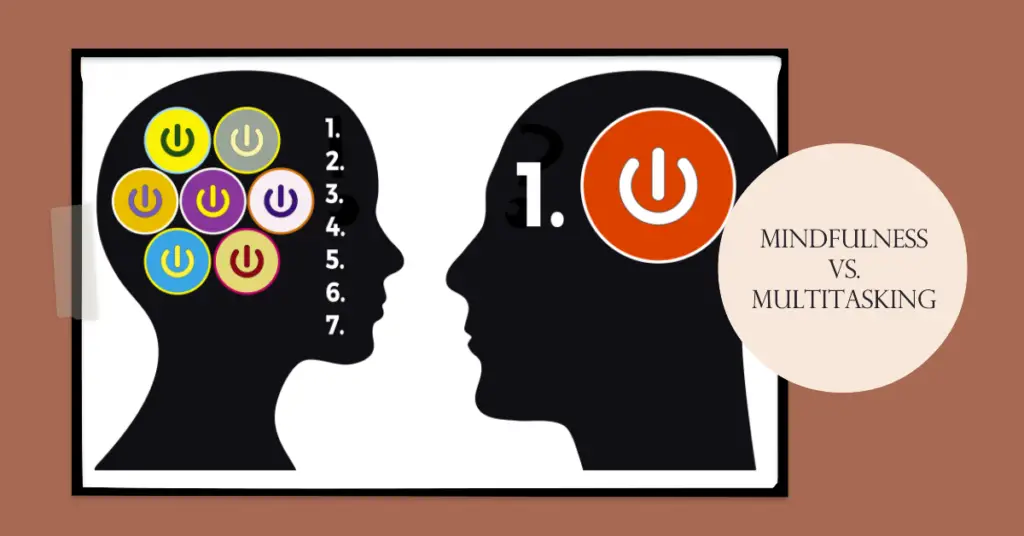Which Is Better Mindfulness Or Multitasking ?

Introduction
Hello my dear friends! In our insanely busy world today, finding ways to boost productivity, resilience and mental well-being has become increasingly important. Two popular approaches, mindfulness and multitasking, often battle for the title of “best strategy,” leaving many people wondering which one is truly better.
In this blog post, we’ll dive into the definitions of both concepts, explore their benefits and drawbacks on our lives, and ultimately help you decide which approach best suits your individual needs.
Are you ready to unravel the mystery behind these two strategies? Let’s embark on a journey that will enhance your focus, improve your efficiency, support your mental health goals – and ultimately make you more effective in work and life.
Key Takeaways
- Mindfulness is generally a better approach than multitasking for productivity and mental well – being.
- Mindfulness improves focus, attention span, memory retention, and reduces stress levels.
- Multitasking can lead to decreased work quality and increased stress levels due to divided attention.
- It’s important to find a balance between mindfulness and multitasking and use them in appropriate situations for maximum effectiveness.
Understanding Mindfulness And Multitasking – Which One Is Better?
Mindfulness and multitasking are two different approaches to managing tasks that have different effects on productivity and well-being.
Definition Of Mindfulness And Multitasking
Mindfulness and multitasking are two popular concepts often discussed in relation to productivity and mental health. Mindfulness is the practice of maintaining a moment-by-moment awareness of our thoughts, emotions, bodily sensations, and surrounding environment without judgment.
This focused attention allows us to stay present in the task at hand, which enables us to make better decisions and respond more effectively to challenges.
For example, imagine you’re working on an important report while also trying to reply to emails and answering phone calls at the same time – that’s multitasking. In contrast, practicing mindfulness can also involve taking a few minutes each day for deep breathing exercises or meditation before diving into your work tasks with full concentration.
Their Effects On Productivity And Well-being
Mindfulness and multitasking have differing effects on productivity and well-being. Mindfulness practices can significantly boost productivity by helping individuals to focus better, concentrate more deeply, and retain information much better.
In contrast, multitasking can lead to increased stress levels, cognitive overload, reduced attention span, and decreased work quality.
In terms of well-being, mindfulness is highly regarded as a way of managing stress levels effectively. Research shows that daily mindful meditation practice decreases cortisol (the hormone associated with stress) levels over time which in turn leads to lower anxiety rates.
On the other hand, although multitasking makes you feel energized at first when done for extended periods it could result in burnout or fatigue-related illnesses due to the high strain placed on your central nervous system each day.
Benefits And Drawbacks Of Mindfulness
Mindfulness offers many benefits, including improved focus, reduced stress and anxiety levels. But implementing the practice can be challenging.
Improved Focus And Attention Span
Mindfulness training is an effective way to enhance focus and attention span, making it easier to complete tasks efficiently and effectively. Focusing on the present moment helps eliminate distractions caused by thoughts about the past or future, which leads to a higher concentration level.
Practicing mindfulness also helps improve memory retention as brain activity related to attention increases. Furthermore, research shows that multitasking can have a negative impact on focus and productivity – sometimes leading to mistakes that could have been avoided if more focused attention was given.
Reduced Stress And Anxiety
Mindfulness has been shown to have a significant impact on reducing stress and anxiety. By focusing your attention on the present moment, you can let go of worries about the future or rumination about the past.
This allows you to experience a sense of calmness and mental clarity that can alleviate feelings of stress and anxiety. Research has also found that practicing mindfulness regularly can lead to physical changes in the brain, such as increased gray matter density in regions associated with emotion regulation and reduced activity in areas related to mind-wandering and self-referential thinking.
On the other hand, multitasking has been found to increase stress levels by overwhelming our cognitive resources and leading us to feel mentally scattered or overloaded. When we try to juggle multiple tasks at once, we may end up doing them all less efficiently or effectively than if we had focused on one task at a time.
This can create feelings of frustration or inadequacy that contribute further to our stress levels.
Challenges In Implementing The Practice
Implementing mindfulness into your daily routine can be a challenging journey, but with consistent effort, it is possible to integrate successfully. Here are some of the common challenges you may face when trying to implement mindfulness:
- Time: Finding the time to practice mindfulness can be challenging, especially if your schedule is busy. Start by setting aside a few minutes each day to practice and gradually increase the duration.
- Commitment: Making a commitment to practicing mindfulness regularly can be difficult, and it requires discipline and consistency.
- Distractions: External distractions such as noise or interruptions can make it difficult to focus on the present moment and practice mindfulness effectively.
- Mind Wandering: Your mind may wander during meditation, which is normal, but it’s essential to bring your attention back to the present moment without judgment.
- Expectations: Having unrealistic expectations about how quickly you will see results from your mindfulness practice can cause disappointment and frustration.
Remember that developing a consistent mindfulness practice takes time and effort. By focusing on the benefits of mindfulness and committing to a regular practice, you can overcome these challenges and improve your overall well-being.
Benefits And Drawbacks Of Multitasking

Multitasking may seem like a time-saver, but it can come at a cost; let’s take a closer look at the benefits and drawbacks of this approach.
Increased Productivity And Efficiency
Mindfulness and multitasking both aim to increase productivity and efficiency, but they do so in different ways. While multitasking allows you to accomplish several tasks simultaneously, it can lead to decreased quality of work due to divided attention and increased stress levels.
On the other hand, mindfulness helps improve mental clarity, focus, and concentration by training your mind to stay present in the moment. This leads to more efficient use of time as you become better at prioritizing tasks based on their importance and relevance.
For example, incorporating a brief mindfulness practice during breaks between tasks can help refresh your mind for better focus when tackling the next task.
Decreased Quality Of Work
Multitasking may seem like a great way to accomplish more in less time, but it can actually lead to decreased quality of work. When you try to juggle multiple tasks at once, your brain switches back and forth between them rapidly.
For example, imagine trying to write an important report while also answering emails and checking social media notifications. You might find yourself struggling to come up with the right words or forgetting key details because your attention is divided.
Increased Stress Levels
Multitasking can increase stress levels, leading to burnout and decreased productivity. When we try to do too many things at once, our brain has to constantly switch focus between tasks, leaving us feeling frazzled and overwhelmed.
This can cause our stress levels to spike, impacting both our mental health and physical wellbeing. Studies show that individuals who engage in mindfulness practices experience reduced levels of stress and anxiety.
By focusing on the present moment instead of trying to juggle multiple tasks simultaneously, we can train our minds to be more calm and centered even in stressful situations.
Which Is Better: Mindfulness Vs. Multitasking?
When it comes to choosing between mindfulness and multitasking, it’s important to consider the benefits and drawbacks of each strategy, as well as contextual factors such as task complexity and personal preferences.
Comparison Of The Benefits And Drawbacks Of Each Approach
In this section, we will compare the benefits and drawbacks of mindfulness and multitasking to help you better understand which approach might be more suitable for your lifestyle and productivity needs.
| Approach | Benefits | Drawbacks |
|---|---|---|
| Mindfulness | – Improves concentration, memory, and productivity. – Makes you a calmer and more productive person. – Better feelings throughout the day and better work performance. – Allows you to expend your energy in the present rather than in the future. | – Challenges in implementing the practice. – Potentially reduced multitasking efficiency. – Requires consistent practice for optimal benefits. |
| Multitasking | – Increased productivity and efficiency Good skill to develop in certain situations. – Can handle multiple tasks simultaneously. | – Decreased quality of work Multitasking is a myth, and mindfulness is better. – Increased stress levels Reduction in focus and attention to individual tasks. |
As you can see from the table above, mindfulness offers several benefits, including improved concentration, productivity, and overall well-being. On the other hand, multitasking can lead to increased productivity and efficiency, but often at the expense of the quality of work and increased stress levels. It is essential to consider these factors and your personal preferences when deciding which approach to adopt in your daily life.
Contextual Factors To Consider When Choosing A Strategy
When trying to decide between mindfulness and multitasking, it’s important to consider the context in which you’ll be using each strategy. For example, if you’re working on a complex project that requires your full attention and focus, mindfulness may be the better choice as it can help improve concentration and cognitive performance.
Additionally, it’s worth considering your personal preferences and strengths. If you’re someone who struggles with stress management or mental clarity during high-pressure situations, incorporating more mindfulness practices into your daily routine could benefit you greatly.
Ultimately, there is no one-size-fits-all answer when it comes to choosing between these two approaches.
How To Incorporate Mindfulness And Multitasking In Your Life

To find a balance between mindfulness and multitasking, start by prioritizing tasks based on their importance and urgency, then assign time blocks for each task while minimizing distractions.
Finding A Balance Between The Two Strategies
Finding a balance between mindfulness and multitasking is essential to maximizing productivity and maintaining mental health. Here are some tips for incorporating both into your daily routine:
- Prioritize tasks: Identify which tasks require your full attention and focus on them without distractions. For other less critical tasks, you can practice mindful multitasking.
- Schedule breaks: Taking short breaks is crucial to preventing burnout and maintaining focus. Use this time to practice mindfulness techniques such as deep breathing or meditation.
- Be present: Whether you are practicing mindfulness or multitasking, stay present in the moment and avoid getting distracted by external factors.
- Avoid overloading: Trying to do too many things at once can lead to decreased productivity and increased stress levels. Set realistic goals that allow you to balance both strategies effectively.
- Practice self-awareness: Pay attention to how each strategy affects your mental state and work performance, adjust accordingly.
Remember that finding a balance takes time and effort, but it’s worth it in the end for better overall well-being and productivity levels.
Best Practices For Mindful Multitasking
Mindful multitasking can be an effective strategy for maximizing productivity without sacrificing your mental health. Here are some best practices to help you achieve this balance:
- Prioritize your tasks: Identify the most important tasks that require your full attention and focus on them first.
- Set realistic goals: Break down larger projects into smaller, actionable tasks, and set achievable goals for each one.
- Limit distractions: Turn off notifications on your phone or computer, close unnecessary tabs, and minimize any potential interruptions.
- Practice mindfulness techniques: Incorporate breathing exercises, meditation, or other mindfulness practices to stay present and focused while multitasking.
- Take breaks: It’s important to take regular breaks to avoid burnout and increase overall productivity.
- Be flexible: Allow yourself to adjust your approach as needed, depending on the task at hand and the level of concentration required.
By adopting these best practices for mindful multitasking, you can improve your performance while maintaining a healthy work-life balance. Remember that both mindfulness and multitasking have their benefits and drawbacks, so it’s all about finding the right balance for you.
Identifying When To Use Each Approach
To determine when to use mindfulness and multitasking, consider the following:
- The nature of the task: Mindfulness is better suited for tasks that require undivided attention and focus, such as writing or reading. Multitasking, on the other hand, is more appropriate for routine or repetitive tasks.
- Time constraints: If you have a deadline looming, multitasking may be necessary to complete tasks quickly. However, if you have enough time, practicing mindfulness can improve your productivity in the long run.
- Mental state: If you’re feeling stressed or overwhelmed, taking a mindful approach can help reduce stress and increase mental clarity. On days when you feel energized and productive, incorporating some multitasking can help maximize your output.
- Personal preference: Everyone has their own style of working. Experiment with different approaches to figure out which works best for you and in which situations.
Remember that there is no single “correct” approach – it’s all about finding what works best for you in different contexts. By being mindful of your mental state and the nature of the task at hand, you can optimize your work performance and achieve your goals more effectively.
Recap on Mindfulness vs Multitasking
We’ve seen that multitasking refers to juggling multiple projects at once, a practice often celebrated in our fast-paced world. Despite our belief in our ability to multitask, research suggests that multitasking can actually slow us down, as it requires us to shift our attention back and forth between tasks instead of allowing us to focus on one thing and complete it quickly and efficiently.
Multitasking is often deemed a valuable skill, but it can come with a cost to our productivity and wellbeing. This is where mindfulness enters the conversation. Mindfulness allows us to be fully engaged in the current moment, to be deeply aware of what’s happening around us. By promoting the ability to focus, mindfulness also increases the quality of our work and our satisfaction with it.
Despite the challenges of juggling multiple tasks, many of us identify as multitaskers. However, understanding the potential drawbacks of this approach and the benefits of mindfulness can provide us with better strategies for managing our work and our lives. In summary, while multitasking requires constant task-switching, mindfulness allows us to immerse ourselves in one task at a time, promoting efficiency, satisfaction, and a greater awareness of our surroundings.
Conclusion : Mindfulness is Better Than Multitasking
In the battle between mindfulness and multitasking, it’s clear that mindfulness comes out on top. While multitasking may seem like a way to get more done in less time, research shows that it actually decreases productivity and quality of work.
On the other hand, practicing mindfulness can lead to better focus, attention span, and mental health.
It’s important to find a balance between the two approaches and use them in contextually appropriate situations for maximum effectiveness.
At the end of the day, choosing mindfulness over multitasking will not only make you a happier person but also a more productive one who is prepared for career readiness challenges ahead.
Frequently Asked Questions on Which Is Better Mindfulness Or Multitasking
It depends on the situation, but generally mindfulness is better than multitasking.
Multitasking can increase productivity and the ability to adapt to changing circumstances. It can also save time by allowing you to switch between tasks quickly.
Multitasking can lead to mistakes, decreased focus, and increased stress. It can also take longer to complete multiple tasks when constantly switching back and forth between them.
Mindfulness meditation and training has numerous benefits, including reduced stress, increased focus and awareness, and improved overall well-being.
There are not many cons to mindfulness, but some people may find it difficult to practice or may not feel like they have the time for it.
Yes, practicing mindfulness can actually help with multitasking by improving focus and the ability to switch between tasks more efficiently.
Generally, focusing on one task at a time can lead to higher quality work and fewer mistakes compared to constantly switching between tasks.
Yes, in today’s fast-paced world, multitasking has become the norm for many people.
Mindfulness is the practice of being aware of the present moment and accepting it without judgment.
Mindfulness can help us reduce stress, increase focus and awareness, and improve our overall well-being.






